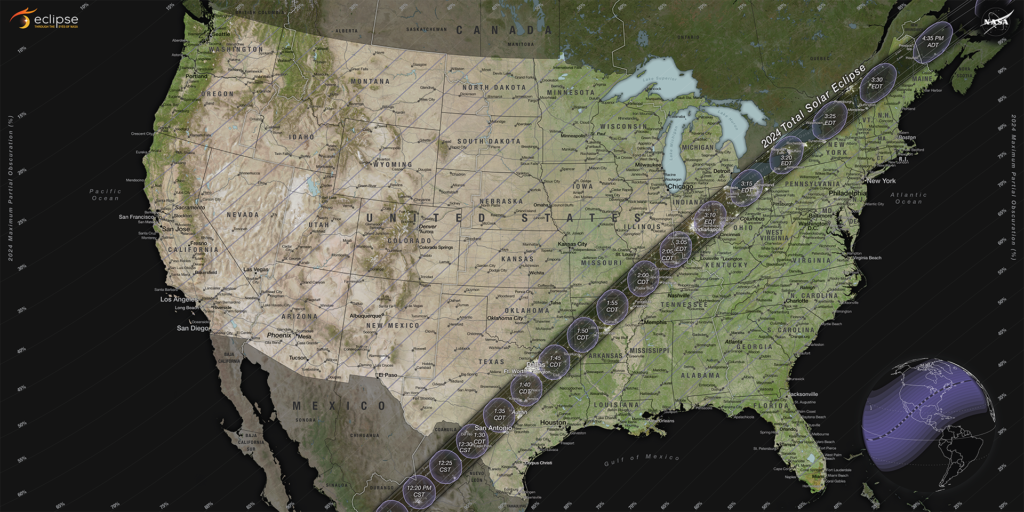astronomy
Don’t Miss Out on the Spectacular Show: Join NASA for the Total Solar Eclipse!
Get ready for an exciting celestial show! Join NASA for the total solar eclipse on April 8th and experience the wonder of the Moon passing in front of the Sun. #eclipse2024 #NASAEclipse

Get ready, North America! On Monday, April 8th, a captivating total solar eclipse will grace the skies, and NASA is inviting all of us to participate in this remarkable event. Whether through in-person events, engaging in NASA science activities, or tuning in online, there are numerous ways for everyone to be a part of this extraordinary celestial phenomenon.
Millions of lucky individuals within the path of totality – which stretches from Texas to Maine in the United States – will experience the awe-inspiring total solar eclipse where the Moon will completely block out the Sun. For those elsewhere in the contiguous United States, worry not! You’ll still have the chance to witness a partial solar eclipse, where the Moon partially covers the Sun. Just remember to view it safely!
To enhance your eclipse experience, NASA will be hosting live coverage of the event starting at 1 p.m. EDT. Their broadcast will include mesmerizing live views of the eclipse from various locations across North America, intriguing appearances by NASA experts and astronauts aboard the space station, and an exclusive peek into NASA’s exciting eclipse science experiments and watch parties throughout the country. The three-hour broadcast will be available for streaming on NASA+, aired on NASA TV, and via the agency’s website. Isn’t technology wonderful?
Oh, and let’s not forget – NASA will also be hosting a watch party for the eclipse in Spanish on YouTube, starting at 1:30 p.m. Don’t you just love the inclusivity?
For those who prefer a more raw and unfiltered experience, NASA’s telescope-only feed will be available on NASA Television’s media channel and YouTube, commencing at 1 p.m. The feed will switch between multiple locations based on weather conditions, eclipse progress, and feed availability.
NASA will also be hosting a Spanish eclipse watch party on YouTube, beginning at 1:30 p.m. The event can be accessed through the following link: https://youtube.com/live/-VglV73zVvU.
To Watch the Total Solar Eclipse
NASA will stream a telescope-only feed of the eclipse on NASA Television’s media channel and YouTube. The stream will begin at 1 p.m. and last for three hours. Multiple locations will be included in the feed, with switches based on weather, eclipse progress, and feed availability. Possible locations may include:
- Carbondale, Illinois
- Cleveland
- Dallas
- Houlton, Maine
- Indianapolis
- Junction, Texas
- Kerrville, Texas
- Mazatlán, Mexico
- Niagara Falls, New York
- Russellville, Arkansas
- Torreón, Mexico
- Tupper Lake, New York
NASA’s Wallops Flight Facility in Virginia will offer a live stream with commentary of three sounding rocket launches for the Atmospheric Perturbations around Eclipse Path mission. The live stream will start at 2:30 p.m. on NASA Wallops’ YouTube channel and end after the final sounding rocket launch.
Users can utilize NASA’s interactive Eclipse Explorer Map to monitor the progress of the total solar eclipse on April 8 as it traverses North America in real time. By using this tool in advance, one can search for eclipse timing based on zip code or city, receive real-time weather updates, determine the percentage of eclipse coverage, and even obtain corona predictions for locations in the path of totality.
Now, if you’re itching for some rocket action, NASA’s Wallops Flight Facility in Virginia has you covered. They’ll be broadcasting three sounding rocket launches for the Atmospheric Perturbations around Eclipse Path mission. The livestream begins at 2:30 p.m. on NASA Wallops’ YouTube channel and concludes after the final launch. Prepare to witness science in action!
To enrich your eclipse experience even further, make sure to check out NASA’s interactive Eclipse Explorer Map. This incredible tool allows you to track the total solar eclipse in real-time on April 8th as it transcends North America. You can search by zip code or city for precise eclipse timing, get real-time weather updates, ascertain the percentage of eclipse coverage, and even check out a corona prediction for locations in the path of totality. How cool is that?
For media professionals, NASA has provided an assortment of resources on their eclipse website. If you’d like to request an eclipse interview with NASA, whether remote or in-person, please contact agency-eclipsemedia@mail.nasa.gov. Additionally, you can find details about in-person eclipse events and registration requirements specifically crafted for media on the NASA website.
Keep a lookout for some stellar eclipse photos, as NASA will be sharing them on their Flickr account. Prepare to be amazed!
If you’re eager to learn more about this upcoming total solar eclipse, visit go.nasa.gov/Eclipse2024 for a wealth of valuable information.
The celestial stage is set, and the audience awaits! Get ready to witness the magic of the total solar eclipse with NASA as your guide.
NASA eclipse photos will be shared on the Flickr account.
To learn more about the total solar eclipse, visit: